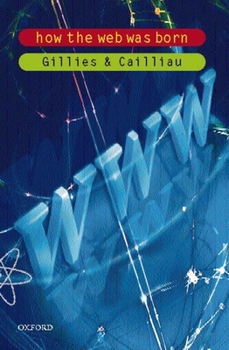How the Web was Born: The Story of the World Wide Web
In 1994, a computer program called the Mosaic browser transformed the Internet from an academic tool into a telecommunications revolution. Now a household name, the World Wide Web is a prominent fixture in the modern communications landscape, with tens of thousands of servers providing information to millions of users. Few people, however, realize that the Web was born at CERN, the European Laboratory for Particle Physics in Geneva, and that it was invented by an Englishman, Tim Berners-Lee.
Offering its readers an unprecedented "insider's" perspective, this new book was co-written by two CERN employees--one of whom, Robert Cailliau, was among the Web's pioneers. It tells how the idea for the Web came about at CERN, how it was developed, and how it was eventually handed over at no charge for the rest of the world to use. The first book-length account of the Web's development, How the Web was Born draws upon several interviews with the key players in this amazing story. This compelling and highly topical book is certain to interest all general readers with a taste for the Web or the Internet, as well as students and teachers of computing, technology, and applied science.
Offering its readers an unprecedented "insider's" perspective, this new book was co-written by two CERN employees--one of whom, Robert Cailliau, was among the Web's pioneers. It tells how the idea for the Web came about at CERN, how it was developed, and how it was eventually handed over at no charge for the rest of the world to use. The first book-length account of the Web's development, How the Web was Born draws upon several interviews with the key players in this amazing story. This compelling and highly topical book is certain to interest all general readers with a taste for the Web or the Internet, as well as students and teachers of computing, technology, and applied science.
Format:Paperback
Language:English
ISBN:0192862073
ISBN13:9780192862075
Release Date:January 2000
Publisher:Oxford University Press
Length:392 Pages
Weight:0.96 lbs.
Dimensions:0.8" x 5.1" x 7.7"
Customer Reviews
2 ratings
Once upon a time in the web!
Published by Thriftbooks.com User , 19 years ago
The Physician Gillies and computation scientific Cailliau gives us an impressive recount, without technical lexicon, about how the actual Web spouted since a Physics lab in Geneva environs. All the implications generated by this colossal invention, including the whole change of paradigms and profound transformations in our quotidian lives are described with notable erudition and precision. Once you have started it will be too hard to leave this passionate reading.
Gripping, Rivetting and Spellbinding
Published by Thriftbooks.com User , 24 years ago
OK, so I'm used to reviewing books of a more technical nature ;)This account of the beginning of the web is both entertaining and informative. I highly recommend it to anybody whose introduction to computer science has been the web: this book will fill in a lot of the gaps about the origins of all sorts of topics ,such as hypertext and networking.I find it interesting that the authors did not always take a linear approach to their subject. Several chapters concentrated on a particular sub-topic, bringing it forward from its root in the fifties or sixties or even earlier, all the way through the nineties.Then the next chapter would likewise deal with a different but related sub-topic. I found this non-linear approach to be much like the World Wide Web itself. Considering one of the authors was intimately involved with the birth of the Web, I wouldn't be surprised if the book were intended to flow this way....it makes it so that you could conceivably jump around from chapter, just like jumping from hyperlink to hyperlink....This book might also make good reading for people who are close to web geeks, but aren't geeks themselves. As long as they are intelligent enough to understand computing concepts, it will help explain to them what this fascination of ours is all about. Hey, it may even get THEM interested ;)






